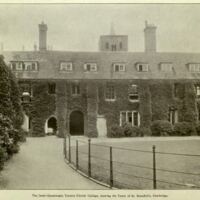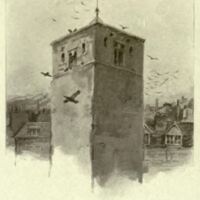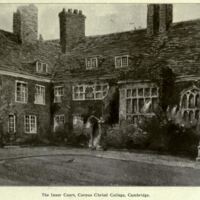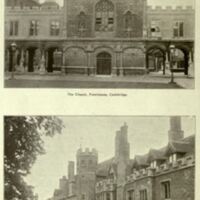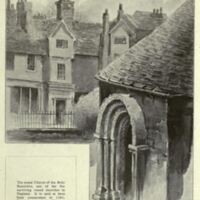Subject
Cambridge was not visited by Bartlett on his tour of Mayflower sites in the 1850s. However, the growing importance of John Robinson to the story of the Mayflower over the nineteenth-century saw the location grow in significance. Robinson attended Corpus Christi College at the University of Cambridge, receiving his Bachelor of Arts degree in 1596 before being ordained a priest of the Church of England. Robinson went on to become one of the early proponents of Brownist Separatism in Britain and is today regarded as a founding figure of the Congregationalist Church. Mackennal makes extended reference to the recent interest and research into Robinson in the introduction to this chapter. Whymper provides illustrations of locations associated with Robinson and there are a number of photographs of Cambridge from the original 1899 edition of the text included alongside.
“THE name of John Robinson has a place of its own among the Pilgrim Fathers. In an age of sharp controversy he took an active part, but he retained to the end an open mind and, in a remarkable degree, quietness and charity of spirit. In the midst of discouragements and accumulating disappointments, his trust in God's leading never wavered, and therefore his courage upheld him and became the strength and stay of his little flock in the hour of decision.
It is only quite recently that the place of his birth has been fixed. The Rev. W. H. Burgess, by diligent and successful search of wills and registers, has settled the long doubt, and by documentary evidence has settled the honour on Sturton-le-Steeple, in the county of Nottingham, and a short distance from Gainsborough. John Robin- son, of Scrooby and Leyden, was probably born about 1576; and there is ground for believing that, while still a mere youth of seventeen, he entered the University when Cambridge was keenly alive to the religious movements of the time.
[…]
It so happens that in Corpus Christi College have survived even more complete and undoubted remains of the Elizabethan period than in many of the other Cambridge colleges. The visitor who now wanders into the old court, or studies the Saxon architecture in St. Benedict's Church, looks upon buildings upon which the eye of John Robinson may have rested hundreds of times. If the entry quoted above really refers to the great Separatist teacher, then undoubtedly he often trod the picturesque old court, and often entered the church so rich in Saxon remains. He is not enrolled upon the list of famous men who have gone forth from Corpus, or, as in his day it was called, Bene't College. But though his name does not stand beside those of Matthew Parker, Thomas Tenison, Nicholas Bacon, Christopher Marlowe, and others, it may yet be doubted whether any one of these has so potently influenced the thought and life of succeeding generations as the quiet student who first in his own mental and spiritual life worked out the problem of religious liberty, and then spent his life in striving to bring others into that liberty wherewith Christ had made him free.
Corpus Christi now makes a much more imposing show among the many architectural glories of Cambridge than it did three centuries since. But with the splendid range of recent buildings facing Trumpington Street and with the great new quadrangle we have nothing to do. These came into existence long after John Robinson's day. The visitor who passes through the great quadrangle into the inner court comes upon a range of buildings that present now almost the identical features which they possessed in 1598. The engravings of Corpus which accompany this chapter enable the reader to look upon the identical walls and windows and ranges of rooms with which John Robinson himself was familiar for years. The old hall has fallen from its early dignity, and is now merely a kitchen; but the handsome window is as it was three centuries ago.”

